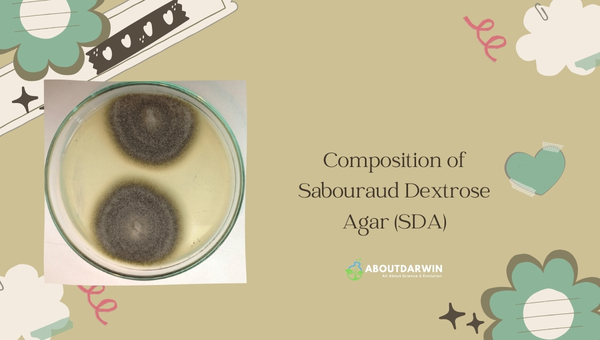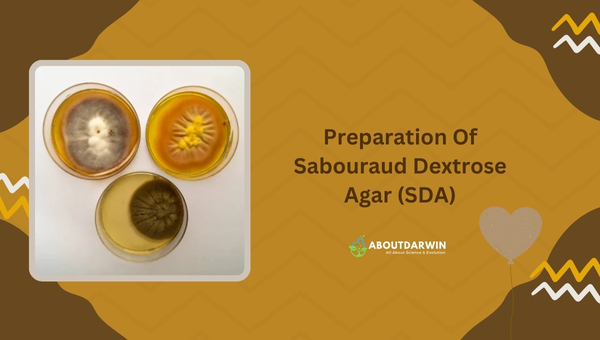Physical Address
304 North Cardinal St.
Dorchester Center, MA 02124
Welcome to this comprehensive guide of everything you need to know about Sabouraud Dextrose Agar (SDA). As an essential medium in microbiology labs worldwide, understanding SDA like the back of your hand could make or break your research results.
In this article, we’re delving deeper into its composition, principle uses, how to prepare it safely and accurately, and how to identify the various colony morphologies SDA uniquely presents.
Sabouraud Dextrose Agar (SDA) is a specialized growth medium primarily used for the culture of fungi and yeast. It was created by Raymond Sabouraud in 1892 to diagnose skin diseases caused by fungal infections. The unique composition of SDA inhibits bacterial growth while promoting the healthy development of yeast and fungi.
Contents
In the world of microbiology, media like the Sabouraud Dextrose Agar (SDA) are integral for the growth and study of organisms.

I’ve found it fascinating to delve into what makes up these media.
Every great recipe starts with ingredients – and SDA is no different! Here are its primary components:
These key components form the bedrock from which we cultivate samples, a microbial feast fit for fungi!
As in any recipe, each ingredient in SDA has its role.
Peptone wears many hats – it not only supplies nitrogen but also vitamins and other essential growth elements. Picture it as a nutrient-filled buffet fueling organism reproduction.
Dextrose plays another critical part in this mix. Think back to when you’ve had a long day at work – sugar boost, right? Similarly, dextrose provides carbohydrates that fungi use as energy sources.
Then comes our firming agent – agar. This water-soluble substance gives us the gel-like texture ideal for cultivating organisms. Essentially, agar helps create a comfortable home where fungi can chill out and multiply.
We also add antibiotics like Chloramphenicol or Gentamicin to stop unwanted guests – bacteria – from crashing our fungal party and making themselves at home on our plate!
Also Read: Uncover 1890 Census Substitutes for Genealogical Insights
The ingenious design of Sabouraud Dextrose Agar (SDA) is worth diving into. Understanding the principles behind the usage of SDA can illuminate how critical the composition is in yielding accurate results. Let’s break it down:
Now, you may be wondering why SDA particularly encourages fungal and yeast growth while stunting that of bacteria. The secret lies in its unique recipe.
Here’s how it works: these ingredients create an ideal environment for fungi to thrive while inhibiting unwanted bacteria from contaminating your culture. Think about setting up a party where only certain guests are invited – SDA does just that but with microorganisms!
Regulating pH is another critical function performed by SDA. What’s fascinating here is that this medium maintains a slightly acidic pH (~ 5.6). This acidity plays two crucial roles:
This unique capability enables researchers to cultivate fungi and yeast without significant bacterial interference.
To recap, Sabouraud Dextrose Agar uses its well-composed ingredients to facilitate an ideal growing environment for fungi and yeast cultures by providing nutritional sustenance while maintaining an optimal pH level.
Also Read: Uncover 1890 Census Substitutes for Genealogical Insights
As you might guess, Sabouraud Dextrose Agar (SDA) is not something I use in my everyday cooking or cleaning routines.
But in certain specialized fields like medicine and industry, it plays a critical role. I hope that digging into these uses will give you a stronger grasp of the practical importance of SDA.
In the realm of medicine, SDA is essentially the workhorse of diagnostic microbiology labs. Its main task? Isolating and identifying fungi present in various types of biological specimens.
See, when doctors suspect a fungal infection – be it on your skin, nails, or even inside your body – they send a sample to their lab friends.
These lab techs then pour the lysed sample onto an SDA plate and let nature run its course. Given the right conditions, fungi start growing into visible colonies within these plates, where further identification procedures take place.
Here are some organisms that can be cultivated with this agar:
Thus, if you’ve ever had an odd rash or persistent cough diagnosed as a fungal infection, chances are, at some point, there was an SDA plate involved!
Food factories regularly use it to check for unwanted yeast or molds in their products – no one wants surprise fungi turning up in their snacks, after all! It’s also commonly used within water testing laboratories to ensure drinking water safety.
The cosmetics industry is another major consumer of SDA plates. Just as in food processing, these labs use SDA to check their products for mold and yeast contamination. The last thing I’d want is to put on a lotion, knowing it could be hosting a fun, fungal party!
Hopefully, exploring the uses of Sabouraud Dextrose Agar both inside and outside the medical field shines a spotlight on its importance in our daily lives. Stay tuned as we keep peeling away the layers of this fascinating topic!
Also Read: Unraveling the Mystery: What is a Suffix in a Name?
In the fascinating world of microbiology, preparing a culture medium is an art as much as it is science. Be it in laboratory settings or real-world industrial applications, the preparation of Sabouraud Dextrose Agar (SDA) is a vital skill for professionals to master.

This section aims to provide you with a detailed, step-by-step guide on how this essential solution is prepared from scratch.
Getting your hands dirty in the lab? It’s crucial to follow these steps meticulously when crafting your batch of SDA:
Remember, folks – precision and patience are key when following this recipe!
Also, note that due care and attention should also be given to safety precautions while crafting SDA solutions:
Creating high-quality culture mediums like Sabouraud Dextrose Agar not only requires proper technique but also vigilance in maintaining safety standards in your workspace.
If you’re an aspiring microbiologist, a clinical technician, or even just a passionate biology enthusiast, building a solid foundation in preparing culture mediums such as SDA is integral for your journey in the field.
Also Read: Unraveling C.difficile: An Insight into Biochemical Testing
In my experience, one of the most fascinating aspects of working with Sabouraud Dextrose Agar (SDA) is observing the varying colony morphologies that develop on the medium.
It’s almost like a living art exhibit when you scrutinize it under laboratory conditions. Different species of fungi and yeast create unique patterns, colors, and textures that offer critical insights into their nature.
Identifying different colonies becomes a matter of keen observation and understanding certain key distinct features exhibited by fungi and yeast as they grow on SDA:
Of course, these are just rough guidelines – any serious study would involve further confirmatory tests such as microscopic examination because some colonies may emulate others in terms of visual characteristics. But overall, understanding colony morphology provides us a headstart in classification.
Also Read: Identification and Biochemical Testing of Streptococcus pyogenes
It’s essential to wear gloves, lab coats, and goggles for protection. Also, always adhere strictly to the prescribed method of preparation and store it adequately.
Yes, avoid contamination during preparation, measure ingredients accurately, ensure a sterile environment & regulate pH correctly to facilitate fungal growth.
While SDA promotes wide-ranging fungi and yeast cultures, it may not be ideal for certain strains – always verify with relevant guidelines.
Factors such as temperature fluctuations, variation in pH levels, or contamination can negatively impact colony morphology on SDA.
Not exclusively! While often used for isolating pathogenic fungi and yeast in medicine, it’s also instrumental within broader food industry quality control checks.
Wrapping up, I hope this comprehensive discussion has shone a light on the integral nature of Sabouraud Dextrose Agar (SDA) in research and industry.
Despite its humble components, our understanding of its composition, the principle behind SDA, its uses in multiple fields, and the way it helps visualize fungi and yeast transformation are all key to glaring insights.
From enabling medical diagnoses to fostering food safety in industries, SDA plays a critical role. Its preparation may require a keen eye for detail, but the end result is invaluable to stretching our scientific horizons.
As we’ve learned, understanding this culturing media isn’t solely reserved for lab professionals – it’s useful for anyone impassioned by science.